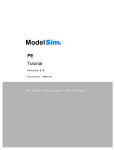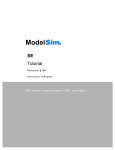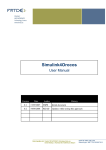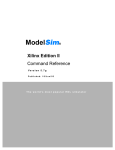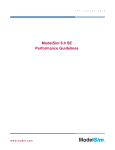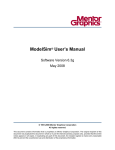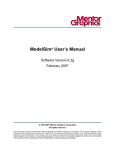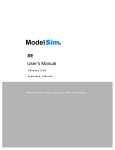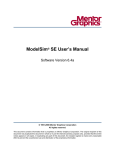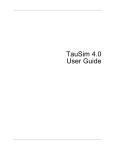Download MODELUSER - Real Intent
Transcript
CONTENTS VHDL: ONE LANGUAGE IS NOT ENOUGH Only a few years ago, the great language war between VHDL and Verilog was raging. Many industry experts said one language would win over the other and that’s what the design community would use. Yes, there has been a winner — and it’s both languages. As a result, the Hardware Description Language market continues to grow. VHDL usage remains strong for a number of reasons. This article focuses on two: VHDL’s history and its functionality. BECOMING A STANDARD VHDL was first intended as a Hardware Description Language for documenting designs. It originated from a US Government/DOD-sponsored effort to overhaul the way integrated circuits were exchanged between companies. In 1987, the IEEE adopted VHDL as a standard and many EDA companies began developing tools supporting the language. VHDL is widely used today. The biggest user communities are Europe and the FPGA markets. Europe always looks for standards when adopting methodologies — and at the time, Verilog was owned by Cadence and not a standard. Conversely, the FPGA vendors had formed an alliance with EDA vendors who only developed VHDL tools. 1 VHDL: ONE L A N G UAG E I S N OT E N O U G H ModelSim capitalizes on the strengths of VHDL and Verilog to bring you the best simulator on the market 2 D E BU G DETECTIVE Introducing Debug Detective: Advanced debug and analysis for ModelSim 3 M A RC O N I ModelSim streamlines distributed system simulation environment development 6 7 FAQ s Getting the most out of ModelSim 8 HDL DESIGN AND TRAINING SCHEDULE DESIGN DISCIPLINE VHDL is able to balance its flexibility and power by enforcing a certain degree of discipline on the designer. Strictly enforced type and other rules define how and when statements can be used. While these rules may appear cumbersome at first, their value in complex designs rapidly overshadows any aspect of the language that could obstruct the design process. Unlike languages such as Verilog, it is not possible in VHDL to compile code then spend hours discovering that your problem is a range or not assigning enough bits to a vector. VHDL is excellent at the higher levels of abstraction — Register Transfer and behavioral. It includes features such as enumerated types, permitting the designer to model without worrying about implementation and allowing synthesis tools to choose the best encoding schemes. POWERFUL FEATURE SET VHDL is highly organized, making use of libraries to store units and allowing connectivity of design units to be controlled by configurations. It has generated functionality that permits units to be replicated easily within loops. You only have to look at the new Verilog 2001 specifications to see an endorsement of long-standing VHDL language TIPS AND TRICKS Expert answers about ModelSim and the simulation process F RO M C O N C E P T TO S I L I C O N Advanced techniques for complex FPGA design C O N TA C T C O N T I N U E D O N PA G E 5 Model Technology, Inc. 10450 S.W. Nimbus Avenue, Bldg. R-B Portland, OR 97223 Phone 503-641-1340 Email [email protected], [email protected], [email protected] Web www.model.com A publication of Model Technology Incorporated Q3 01 MODELUSER 2 MODELUSER Q3 01 Debug Detective™, a new product in the HDL Designer Series family of tools, provides extended debug and design analysis capabilities to the ModelSim® PE and SE simulators. This tool was developed specifically as a natural extension to your ModelSim user interface by adding visualization and unique interactive debugging features. Debug Detective snaps on to your ModelSim installation. When you are ready to use the debug features, they are available via toolbar buttons, pull-down menus or by double-clicking on the region in the Structure window. By referencing the source code displayed in ModelSim’s Source window, Debug Detective renders on-the-fly graphical and tabular views of any level of your design hierarchy. These renderings are completed INTRODUCING DEBUG DETECTIVE, A D VA N C E D D E B U G A N D A N A LY S I S FOR MODELSIM Debug Detective renders views of any and all levels of the design into block, Interface-Based Design, state, or flow chart diagrams. rapidly and without any change to the source code or need for a special database. You can use Debug Detective without any change to your current ModelSim simula- Interface-Based Design view of a structural HDL netlist. tion environment — even your invoke scripts are not affected. Debug Detective produces graphical or tabular representations for any level of your design hierarchy in the Structure window or any section of code displayed in any other ModelSim debug window. The rendered graphical views include state machine diagrams for control logic, flow charts for sequential logic such as testbenches, and block diagrams for structural netlists. In addition to the block diagram view for VHDL and Verilog netlists, the Interface-Based Design™ (IBD™) view can also be rendered. IBD is patent-pending technology from Mentor Graphics and offers a unique image of the netlist. The representation uses a spreadsheet approach to display blocks (columns), signals (rows), and their interconnections. C O N T I N U E D O N PA G E 4 MARCONI DEVELOPS DISTRIBUTED S Y S T E M S I M U L AT I O N ENVIRONMENT Q3 01 MODELUSER Marconi Networks employed ModelSim in its Distributed System Simulation environment to verify C diagnostics on its entire system chassis. Using ModelSim in the distributed CPU environment also provided unprecedented system-level quality assurance of the 272 ASIC system prior to tape out. Marconi Networks — with 55,000 employees in 100 countries — provides key technologies, equipment, and services for the Internet, enterprise networks, and telecommunications systems. Jay Adams, manager of ASIC design at Marconi, was faced with verifying a complete system while maintaining an aggressive product delivery date. He realized that simulation of this magnitude could be accomplished with ModelSim running on hardware with 64-bit operating system support. “In order to achieve the speed needed to make this massive system simulation effective, we needed to explore radical new simulation methods,” explains Adams. Marconi already had a significant investment in testbench technology, with the testbench linked into ModelSim with the Foreign Language Interface (FLI) C-interface. The self-checking test cases also had embedded UNIX®-like scripting built into them. The sophisticated testbench technology ran together with ModelSim in a single threaded application on a single CPU. C A P I TA L I Z I N G O N C O M P U T E POWER The project’s main goal was to achieve the highest quality product while manufacturing it on time. For both hardware and software developers to accomplish their goals, the entire system had to be simulated. Adams wanted to utilize the computing power of Marconi’s substantial compute farm. This required Marconi to solve the problem of linking and synchronizing Marconi partitioned their simulation on 15 separate CPUs. Communication was handled by the RPC server. This implementation enabled software developers to verify diagnostics on the entire system. separate Modelsim simulations running on the farm. To realize that goal, Tim Noh, manager of verification, and Mark Pleso, a lead engineer, saw the use of Remote Procedure Calls (RPC) with a client-server model as the logical next step in the development of Marconi’s verification environment. Since the Marconi team was already familiar with ModelSim’s FLI C interface, the design of the RPC server-client was made much easier. The testbench, system diagnostics and 272 ASICs with embedded memory would communicate through RPC. The RPC libraries allow C language programs to make procedure calls with other CPUs on a network. This is accomplished with a server and client, with each client running on its own CPU. The client sends a request to a server, the server C O N T I N U E D O N PA G E 4 3 4 MODELUSER Q3 01 D E BU G D E T E C T I V E , C O N T I N U E D F R O M PA G E 2 All of these graphical and tabular views speed design understanding, plus enable advanced debugging techniques. Via simulation toolbars on each diagram, you can advance and step simulation time, set breakpoints on state machines and flow charts, add signals to the Wave and List windows, and place probes on your block diagram. Probes function just like the ModelSim examine command. Debug Detective offers animation and cause analysis for additional debug productivity. Animation visually displays the flow of logic in your state diagrams and flow charts. Color changes help you easily trace the path of logic, visually highlighting branches and missed states. VCR-style buttons control your steps through the diagram. Cause analysis works with the ModelSim Wave window to link a specific signal transition event back to the source in a rendered diagram and line in the ModelSim Source window. For a free 30-day evaluation license of Debug Detective, please visit www.debugdetective.com or email [email protected]. Visit w w w. m o d e l . c o m for frequent updates, including Application Notes Product Highlights and Tips and Tricks M A R C O N I , C O N T I N U E D F R O M PA G E 3 “ModelSim is available on all the platforms we used, including Linux®,” explains Noh. “Because of many factors, the 15node parallel simulation environment currently runs on Linux-based hardware. High CPU frequencies and lower cost make a very strong argument for this platform. “ModelSim’s ability to compile the design on our platform of choice —then to E XC E E D I N G E X P E C TAT I O N S use the compiled HDL image on other With 15 separate CPUs running simulta- hardware architectures — made implementation of a multineous ModelSim simuarchitecture verilations, Marconi was fication able to demonstrate a environment a working BXR™-48000 cost-versus— a non-blocking “During the distributed performance 480 Gbps Multiservice environment development, decision.” he says. Switch Router — to “Parallel diagnostic engineers I could not have been more simulation is not and system software the only mode of developers. pleased with the verification,” “Our expectations performance of ModelSim Noh adds. of throughput were “There is a signifexceeded. We were and the responsiveness of icant need to impressed by the share the throughput of this the Mentor team.” compute implementation,” says resources for Noh. “Each CPU load Jay Adams normal, single was about 25 percent. Marconi Networks CPU batch and For this large of a interactive simunetwork of chips, we lation runs as were very happy. well.” “One of the most interesting aspects of E N A B L E S B E S T C O S T- P E R this project was the increased communicaS I M U L AT I O N tion between the two disciplines,” Noh ModelSim’s high-performance VHDL adds. “The software and hardware engisimulation and robust Foreign Language neers were making discoveries soon Interface (FLI) enabled Marconi to use enough to affect the quality of the system UNIX Remote Procedure Calls (RPC) to for less cost.” implement its Distributed System M U LT I - P L AT F O R M M O D E L S I M Simulation environment. D R I V E S LO W C O S T P E R ModelSim’s unique platform independS I M U L AT I O N ence also made it possible to implement the Because of existing testbench tech15-CPU Distributed System Simulation nology, the decision to keep the simulation environment on low-cost, high-performance environment based in UNIX was simple. hardware so Marconi could run valuable Deciding which hardware to use was more verification with the best cost-per-simulachallenging. tion cycle. processes the request appropriately and sends back a response to the client. A separate client was set up for the testbench and C interface to System Diagnostics, and for the VHDL design. Each part of the VHDL RTL design was partitioned to a separate client/CPU with an FLI interface. VHDL, Q3 01 MODELUSER CONTINUED C O N T I N U E D F R O M PA G E 1 features. The new Verilog 2001 specification includes VHDL-like functionality, such as generate statements and use of libraries, to name just a few. Since the first release of VHDL in 1987, other standards have come along to complement the main standard and allow EDA vendors to accelerate their tools. In the early days, there was no standard method of implementing arithmetic functions or wire types and each tool had its own library. This presented two problems. First, the functions were not accelerated and therefore raw code had to be executed, causing performance problems. And second, it was difficult to share code between different tools. Standards such as std logic 1164 — as well as arithmetic and numeric standards — have allowed EDA companies to fully accelerate their tools and enable code to be shared by multiple tools. ModelSim fully accelerates all the standards using its native compiled code architecture. allows you to compile once and run on any hardware platform. All versions of ModelSim — including OEM versions — are compliant with the IEEE 1076.4 VITAL ASIC Modeling Specification. In addition, ModelSim PE and SE both accelerate the VITAL_Timing and VITAL_Primitives packages. The procedures in these packages are hand-optimized and built into the simulator kernel. They are functionally equivalent to the IEEE 1076.4 VITAL ASIC Modeling Specification (VITAL v3.0). An extra level of optimization occurs in the SE product — a built-in compliance checker in ModelSim’s VHDL compiler. To qualify for global acceleration, architecture must be VITAL Level 1 compliant. This check is performed automatically on all entities with GATE-LEVEL ATTENTION Another area where much work has been done in VHDL is at the gate level. This was again necessary because there was no standard way to model gatelevel libraries and therefore no way the modeling could be accelerated by the simulators. VITAL (VHDL Initiative Towards ASIC Libraries) was the first specification to define a standard way to model at the gate level. A simulator is VITAL-compliant if it implements the SDF mapping and if it correctly simulates designs using the VITAL packages, as outlined in the VITAL Model Development Specification. PLATFORM INDEPENDENCE ModelSim was the industry’s first native compiled simulator. ModelSim provides the high-performance benefits of platformspecific native code, plus the unique advantage of platform-neutral compile. ModelSim compiles to a platform-neutral pseudo-RISC code. When you load your design, ModelSim generates native code for the architecture you used to invoke it. ModelSim’s architecture the VITAL_Level 0 attribute set and all architectures with the VITAL_Level 0 or VITAL_Level 1 attribute set. If the model is compliant, the complete model is transformed into a state machine that does the equivalent behavior more efficiently. The multiple VITAL primitives become a single model, which can have a significant effect on the simulation performance. VERILOG EFFICIENCIES Even with this acceleration, using Verilog at the gate level often is more efficient with respect to performance and memory utilization. This is because the Verilog language was built to model at the gate level, whereas VHDL had to be pushed in that direction. This is why many ModelSim users use the seamless mixed-language facility within the tool — they are able to carry on designing at the RTL and behavioral levels with the advantages of VHDL, then, for gate-level modeling, can instantiate a Verilog netlist. The benefits of using Verilog at the gate level include more complete ASIC foundry and backend tool support, plus it allows ModelSim to handle much larger designs at a higher performance level. MODELSIM SUPERIORITY ModelSim has the highest capability of any simulator on the market. Its 64-bit version currently runs on both Solaris and HP, allowing customers to build processes larger than the 32-bit limit of 4 Gb. The recently released ModelSim version 5.5 includes Verilog gate-level optimizations, providing up to 4X faster simulations and up to 3X smaller memory images. One customer using Verilog gate-level optimizations saw a 6.5 Gb image reduced to 1.9 Gb. That reduction allowed the customer to take a 6.5 million-gate design and switch back to the 32-bit version of ModelSim, eliminating the need to use more expensive workstations. The performance of this simulation also improved 2.5X. ModelSim handles large designs within 32-bit workstations, preserving customers’ significant investment in hardware. Having 64-bit support increases ModelSim’s capacity beyond any other simulator on the market. MEETING YOUR PREFERENCES ModelSim has accommodated your simulation language preferences — mixedHDL, HW platform and OS neutral, or native code simulation — since 1995. Performance and functionality should be independent of your HDL because your initial HDL choice most likely will not be your last. With integrated tools like Code Coverage, Waveform Compare, advanced bug tracing, ModelSim is your choice for simulation. Today, ModelSim has 60 percent market share in VHDL, is the industry leader in mixed-language, and is the fastest growing Verilog simulator on the market. That’s why there are more than 60 active partnerships with companies providing additional value to ModelSim and why ModelSim is synonymous with innovation, industry leading technology and superior support. 5 6 MODELUSER Q3 01 FAQS The waveform compare tool can perform comparisons based on a reference signal’s transition. This is commonly known as a “clocked compare.” This reference clock often is a clock, but it could also be any signal such as a data strobe or read enable. Q 1.) Define a virtual type that contains the states virtual type: A 3.) Display the translated value add wave myConvertedSignal Following is an example of a clocked compare. The two datasets min and typ are opened, and a limit of 1000 errors set. All signals are compared with the command compare region — recursive — all. In addition, there are two data comparisons related to the clock. Both are done relative to the rising edge of the tst_pseudo.clock signal (compare clock –rising label). The second reference clock label clocked_delay4 is offset by 4ns. So, the data is compared 4ns after the rising edge of the clock. If you changed this to –4ns, data would be compared 4ns before the rising edge of the clock. Both examples of the clocked compare check the tst_pseudo.data, but with a different clock label (–clock clock_rising and –clock clock_delay4): dataset open min.wlf min dataset open typ.wlf typ compare open -maxtotal 1000 min typ compare region -recursive -all compare signal min:.tst_pseudo.clock typ:.tst_pseudo.clock # compare with clock compare clock -rising clock_rising min:.tst_pseudo.clock compare signal -clock clock_rising -label clocked_data min:.tst_pseudo.data \ typ:.tst_pseudo.data # compare with clock delay compare clock -rising -delay {4 ns} clock_delay4 min:.tst_pseudo.clock compare signal -clock clock_delay4 -label clocked_delay4_data min:.tst_pseudo.data \ typ:.tst_pseudo.data compare info -write compare_info.txt compare start Q A How do I convert signal values to strings? You may want to display certain signal values as strings. For example, rather than displaying the value 0, you may want to display the string idle. The virtual type command allows you to do this. The virtual type command creates a new enumerated type, known only by the GUI. The steps for using the command are: { state0 state1 state2 state3} myState 2.) Define a virtual function for translating the signal values to strings virtual function: {(mystate)mysignal} myConvertedSignal When myConvertedSignal is displayed in the Wave, List or Signals window, the string state0 will appear when mysignal == 0, state1 when mysignal == 1, state2 when mysignal == 2, etc. See the virtual type function in the ModelSim Command Reference for further details. Q A How do I sample signals at a clock change? You can do this easily by adding signals to the list window using the –notrigger argument. –notrigger disables triggering the display on the specified signals. For example: add list clk –notrigger a b c When you run the simulation, list window entries for clk, a, b, and c appear only when clk changes. If you want to display on rising edges only, you have two options: 1.) Turn off the list window triggering on the clock signal, then define a repeating strobe for the list window. 2.) Define a “gating expression” for the list window that requires the clock to be in a specified state. See the add list command in the ModelSim Command Reference for further details. Q A I’m seeing different simulation results from ModelSim and another Verilog simulator. Why is this happening? This may happen as a result of simultaneous events being executed in a different order. The Verilog language does not require simulators to execute simultaneous events in a particular order. Unfortunately, some models are inadvertently written to rely on a particular event order. These models may behave differently when ported to another Verilog simulator. A model with event order dependencies is ambiguous and should be corrected. For example, the following code is ambiguous: module top; reg r; initial r = 0;initial r = 1; initial #10 $display(r); endmodule The value displayed for r depends on the order that the simulator executes the initial constructs that assign to r. Conceptually, the initial constructs run concurrently and the simulator is allowed to execute them in any order. ModelSim Verilog executes the initial constructs in the order they appear in the module, and the value displayed for r is 1. Verilog-XL produces the same result, but a simulator that displays 0 has also produced correct results. Since many models have been developed on Verilog-XL, ModelSim Verilog duplicates Verilog-XL event ordering as much as possible to ease the porting of those models to ModelSim Verilog. However, ModelSim Verilog does not match VerilogXL event ordering in all cases, and, if a model ported to ModelSim Verilog does not behave as expected, you should suspect that there are event order dependencies. See “Event order issues” in the Verilog chapter of the ModelSim User’s Manual for further details. Q A How do I hide library cell signals when saving a waveform file? Gate-level simulations may result in large waveform files because the internal signals of your library cells are saved. The following method will prevent these signals from being saved in a Verilog design. If your cells are enclosed in Verilog `celldefine and `endcelldefine preprocessor directives, you can specify –fast on the vlog command line when compiling the cell library. This will basically hide the innards of the cells and hence the internal signals will not be saved. A further benefit of this methodology is that the cells compiled with –fast will consume less memory. See the “Verilog” chapter in the ModelSim User’s Manual for further details on –fast. Q3 01 MODELUSER TIPS AND TRICKS ModelSim 5.6 SE release includes two new command options that provide Simulation statistics. The Verilog (vlog) and VHDL (vcom) compilers include the –time. ModelSim (vsim) now supports the command simstats. The –time option will report the cumulative wall clock time needed to compile your netlists. The following example reports the cpu time required to compile the Verilog code in the mixed-HDL design in the examples directory. The same format can be used for VHDL (vcom –time *.vhd). vlog –time *.v -- Compiling module cache -- Compiling module memory -- Compiling module proc Top level modules: cache memory proc Process time 0.211199 seconds The simstats command will report the system requirements needed to execute your ModelSim run. For example, you can modify the run command to include the simstats command in the mixed-HDL design in the examples directory . This vsim example will provide the simulation statistics after the run simulation has completed (run –all has stopped): vsim -c -do ‘view *; add wave *; run -all; simstats’ top Results in simulation transcript: # {memory 6992} {{working set} 5696} {time 0.015162} {{cpu time} 0.01} "memory" is the total process size. “working set” is current working set of vsim. "time" is the cumulative wall clock time of the run commands. "cpu time" is the cumulative processor time of the run commands. Processor time differs in wall clock in that process time is only counted when the CPU is actually running vsim. If vsim is swapped out for another process, CPU time does not increase. CPU time eliminates the impact of other processes on simulation statistics. See the ModelSim 5.6 Command Reference Manual for complete description of –time compiler option and simstats command. Using extended VCD and vcdstim to re-simulate a component. The IEEE 1364-2001 Verilog standard added support for extended VCD which provides additional information for bidirectional ports. ModelSim can generate extended VCD files from Verilog, VHDL, or a mixed-language design. This is done using the $dumpports system task within the Verilog language or with the ModelSim vcd dumpports command. To re-simulate a component in a design, re-invoke ModelSim on that component with the -vcdstim option and an extended VCD file that was generated from the ports of the component in a previous run. Viewing VCD files using the vcd2wlf utility. VCD provides a standardized method for saving the output from a simulation. Whether this output comes from another design team in the same company or from an IP vender, a convenient method for viewing this output is needed. ModelSim provides a utility called vcd2wlf that can convert a standard or extended VCD file into a ModelSim waveform database file. You can then view the waveforms by invoking ModelSim using the -view option. Visit w w w. m o d e l . c o m weekly for the latest Tips and Tricks WIN A DIGITAL CAMERA WITH A SNAPSHOT OF YOUR SUCCESS Tell us your most successful implementation of ModelSim and become eligible to win a Canon PowerShot S300 ELPH. Send us a paragraph or two about your success to [email protected] by December 15th for this drawing. But if you miss that deadline, don’t despair, you can enter every quarter (however the prize is subject to change). More exciting still, if you win, your story will be featured in the next issue of ModelUser. We’ll give your paragraphs the full treatment, similar to what we did with Marconi on page 3. 7 8 Model Technology, Inc. 10450 S.W. Nimbus Avenue, Bldg. R-B Portland, OR 97223-4347 877-435-4255/503-641-1340 www.model.com Mentor Graphics Corporation 8005 S.W. Boeckman Road Wilsonville, OR 97070-7777 800-547-3000/503-685-7000 www.mentor.com F RO M C O N C E P T TO S I L I C O N ADVANCED TECHNIQUES FOR COMPLEX FPGA DESIGN With every new design, your challenge gets bigger. You’re faced with creating a better solution in half the time. It’s a daunting task, but there’s a way to succeed. Advanced design techniques can take you to the next level in FPGA design. Whether you’re tackling thousands or millions of gates, you’ll approach design from a whole new perspective. Attend a free, one-day seminar packed with valuable information: • Learn how to apply advanced design techniques for reuse, creation, simulation, synthesis, and management. • Explore how to take your design into a team environment and move your FPGA onto a board in record time. • Gain insight into the most efficient ways to take your next design from concept to silicon — with success. SCHEDULE Tuesday, Oct. 16 — Irvine Thursday , Oct. 18 — San Jose Tuesday , Oct 23 — Dallas Thursday , Oct 25 — Raleigh To see schedules and to register: www.mentor.com/fpgadesign EVENTS For more details, visit our website at www.model.com HDL TRAINING SCHEDULE HDL SIMULATION USING MODELSIM October 15 November 8 November 28 Ottawa Boston San Jose October 10 October 29 November 12 COMPREHENSIVE VHDL October 22 October 22 December 11 Call 800-345-2308 or www.mentor.com/es for updated training dates and registration. Boston Mentor Graphics understands the complexities of today’s electronic designs. Through the public courses listed above, let us help you gain the experience necessar y to discover and overcome your toughest obstacles. Copyright © 2001 Model Technology. Debug Detective, IBD, and Interface-Based Design are trademarks and FPGA Advantage and ModelSim are registered trademarks of Mentor Graphics Corporation. All other trademarks mentioned in this document are trademarks of their respective owners. Printed on Recycled Paper Chicago Dallas EDUCATION SERVICES Toronto Boston San Jose COMPREHENSIVE VERILO G October 29 Chicago Dallas Ottawa HDL DESIGNER SERIES San Jose EXPERT VHDL VERIFICATION October 15 December 3 December 17 DESIGNING WITH FPGA ADVANTAGE ® 10-01-WCI 3001810









